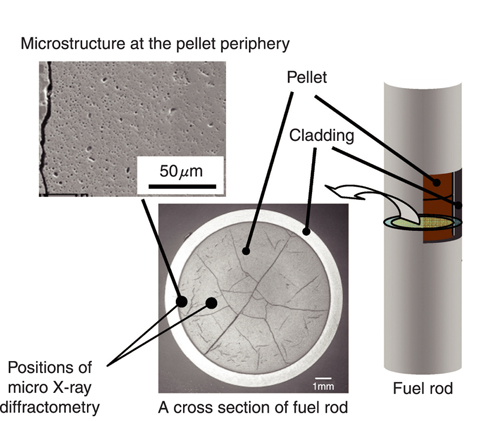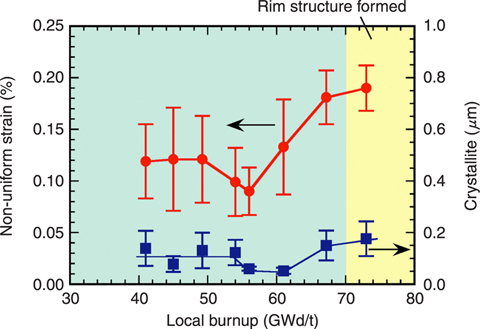
Fig.5-6 Ceramographs of high burnup fuel pellet

Fig.5-7 Local burnup dependence of non-uniform strain and crystallite size in the irradiated fuel pellets
Extending the utilization period of reactor fuel, i.e. burnup extension, is being promoted step by step for the efficient use of natural resources and the reduction of fuel cycle cost. With increase in fuel burnup, fission products accumulate in fuel pellets, and cladding corrosion progresses. Accordingly, in order to promote burnup extension, it is necessary to confirm fuel safety at high burnup.
At the periphery of a high burnup fuel pellet, fine fission gas bubbles precipitate densely and the crystal grains formed at the time of pellet fabrication are subdivided into fine grains was observed (Fig.5-6). A microstructure like this is called "rim structure", and the fine bubbles in this region contain high-pressure fission gas. If the fission gas in this region is released during a reactivity initiated accident (RIA), pellet temperature increase and the cladding deformation would occur due to the degradation of the heat conduction between pellet and cladding which is caused by the additional fission gas release. These phenomena may affect fuel rod safety. Consequently, the investigation of rim structure formation conditions is an important subject of study.
Micro X-ray diffractometry was carried out at the peripheral and mid-radius regions of the fuel pellets which had different burnups. The lattice parameter was calculated from the angles of diffracted peaks, and the non-uniform strain and crystallite size were calculated from the broadening of diffracted peaks. The lattice parameter increased monotonously with increase in burnup, and exhibiting a peak at about 70GWd/t. The lattice parameter slightly decreased above 70GWd/t. The non-uniform strain decreased in the burnup range of 50-55GWd/t and increased above this burnup range (Fig.5-7). The strain energy densities stored in the crystal lattice were evaluated based on the lattice parameters and non-uniform strains. The strain energy densities were constant in the burnup range of 50-55GWd/t. From these results, it is suggested that the main cause of grain subdivision is the tangle of dislocations which forms during irradiation, and that the grain subdivision begins in the vicinity of 50GWd/t. The conditions for formation of rim structure can be understood by investigating the process of microstructure change in high burnup fuel, and this understanding will make it possible to evaluate fuel safety in the high burnup region in further detail.
The present study was conducted in FY2005 with funds for nuclear research from the Ministry of Education, Culture, Sports, Science, and Technology of Japan (MEXT), allocated based on evaluation by the Atomic Energy Commission.